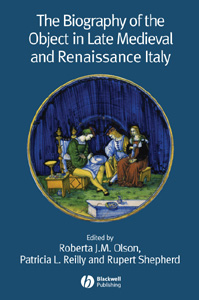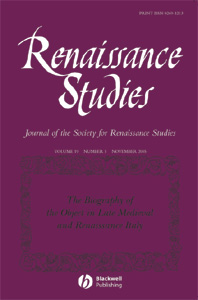

Details
The Biography of the Object in Late Medieval and Renaissance Italy
Roberta J.M. Olson, Patricia L. Reilly and Rupert Shepherd
Blackwell, 2006
Renaissance Studies Special Issues series
also published as Renaissance Studies, volume 19, number 5, November 2005
156 pages, 40 black-and-white illustrations
paperback
ISBN 1405139552
View the journal issue’s details on the Wiley Interscience website (with access to full text for subscribers)
Summary
The famous call, made nineteen years ago by Appadurai and Kopytoff, that students of material culture should study the ‘social life’ of things has, until now, had a limited effect upon students of the Italian Renaissance. The essays in this book – part of the recent burgeoning interest in Italian Renaissance material culture – rise to Appadurai and Kopytoff’s challenge, examining the ‘lives’ led by objects in late-medieval and Renaissance Italy: their creations, lives and subsequent after-lives. Situating the objects and their biographies in their cultural, social and economic contexts, the nine essays discuss the social lives of a range of objects in late-medieval and renaissance Italy: maiolica, sculpture, artist’s autobiographies, plate for the table, cassoni, glassware, prostitutes’ jewellery, miraculous painted images, choir-screens, chapels, and antiquities. Nicholas Penny, in an introductory essay, discusses the forms of evidence at the disposal of students of material culture, and their relationship to the objects whose lives they seem to illuminate.
- New work by young scholars
- Novel approach to the material
- Multiplicity of interpretations and approaches
- Variety of objects (primary material) forming subjects of detailed case-studies
- One of the first works to investigate the ‘social life of things’ in the context of Italian Renaissance art
- Take’s Vasari’s biographical approach to art history and extends it to the objects themselves; but rather than see the history of objects in terms of Vasari’s schema of birth, growth and decay, it demonstrates the continued life of these objects well past the deaths of their creators and patrons
Contents
- Introduction: Toothpicks and green hangings, Nicholas Penny, National Gallery of Art
- I. The creation of the object, Patricia L. Reilly, Swarthmore College
- What you see is what you get: colour in Italian Renaissance istoriato ware, Steve Wharton, University of Sussex
- ‘Sculpsit Cellinius Neptunam’: the biography of the Neptune Fountain in Cellini’s Vita, Victoria C. Gardner Coates, University of Pennsylvania
- II. The life of the object, Rupert Shepherd, Ashmolean Museum
- Banquet plate and Renaissance culture: a day in the life, Valerie Taylor, University of Sussex
- For use and display: selected furnishings and domestic goods in fifteenth-century Florentine interiors, James R. Lindow, Royal College of Art / Victoria & Albert Museum
- Fragments from the ‘life histories’ of jewellery belonging to prostitutes in early-modern Rome, Tessa Storey, Royal Holloway, University of London
- III. The after-life of the object, Roberta J.M. Olson, The New-York Historical Society
- The icon of Santa Maria Maggiore, Rome: an image and its afterlife, Kirstin Noreen, Louisiana State University, Baton Rouge
- One pontile, two pontili: the choir screens of Modena Cathedral, Dawn Cunningham, Ohio State University
- The afterlife of an early medieval chapel: Giovanni Battista Ricci and perceptions of the Christian past in post-Tridentine Rome, Ann van Dijk, Northern Illinois University
- The Scrittoio della Calliope in the Palazzo Vecchio: a Tuscan museum, Andrea M. Gáldy, University of Manchester
